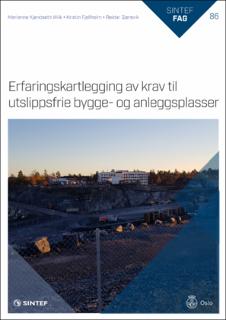| dc.contributor.author | Wiik, Marianne Rose Kjendseth | |
| dc.contributor.author | Fjellheim, Kristin | |
| dc.contributor.author | Gjersvik, Reidar | |
| dc.date.accessioned | 2022-01-18T08:29:54Z | |
| dc.date.available | 2022-01-18T08:29:54Z | |
| dc.date.created | 2022-01-07T08:34:43Z | |
| dc.date.issued | 2022 | |
| dc.identifier.isbn | 978-82-536-1731-2 | |
| dc.identifier.issn | 1894-1583 | |
| dc.identifier.uri | https://hdl.handle.net/11250/2837785 | |
| dc.description.abstract | Standard klima- og miljøkrav for Oslo kommunes egen bygge- og anleggsplasser ble innført i 2019 og Oslo kommune ved Klimaetaten ønsker en erfaringskartlegging av utslippsfrie byggeog anleggsplasser i kommunen. Denne rapporten ser på muligheter, utfordringer, barrierer og løsninger knyttet til strømforsyning, utslippsfrie anleggsmaskiner og lastebiler og ladelogistikk. Bruk av spørreskjema og intervjuer med flere av etatene i Oslo kommune som benytter seg av standard klima- og miljøkrav har dannet grunnlaget for denne kartleggingen. Dialogen med etatene viser at utviklingen så langt er i tråd med målet om at kommunens byggeplasser skal være utslippsfrie i 2025, og rammeverket fungerer i tråd med hensikten. Det er uproblematisk med mindre elektriske maskiner og utstyr, men det er fortsatt noen utfordringer knyttet til strømforsyning og ladelogistikk når flere, store anleggsmaskiner opererer samtidig. Det rapporteres om at elektriske anleggsmaskiner fører til mindre støy, mindre forurensning, bedre luftkvalitet og bedre arbeidsmiljø. De viktigste barrierene og utfordringene som er klarlagt viser at det kan være lange avstander til deponi som fører til at det kan være vanskelig å benytte seg av utslippsfrie løsninger og som fører til at det benyttes biodrivstoff eller fossilt drivstoff. Det er fortsatt få tilgjengelige elektriske anleggsmaskiner og lastebiler og høy etterspørsel. I noen tilfeller er det problematisk med provisoriske strømforsyningsløsninger og det kan føre til logistikkutfordringer på byggeplass. Det er også identifisert flere muligheter og løsninger som blant annet ser på hvordan man kan tilpasse arbeidsrutiner og ladeløsninger til en utslippsfri byggeplass og få til en mer effektiv lokal utnyttelse av masser for å redusere transportbehovet. Større behov for samhandling og dialog i en tidlig fase både mellom kommune og leverandører, men også med strømleverandører har blitt tydelig gjennom kartleggingen. | |
| dc.description.abstract | The City of Oslo’s Climate Agency has engaged SINTEF to carry out a survey of emissionfree building and construction sites for Oslo Municipality's projects. The principal themes are electricity supply, emission-free construction machinery and vehicles, and charging logistics, studying associated experiences and barriers. This report assesses building site experience from relevant projects and includes detailed studies of machine fleets, energy consumption and energy supply. The results indicate that the development towards emission-free building and construction sites is progressing rapidly, although some barriers and challenges remain. All of the municipality's building and construction sites shall be emission-free by 2025. Standard climate and environment requirements for Oslo Municipality's building and construction sites were introduced in 2019. With this new framework, contractors who can offer emission free construction machinery and vehicles in building and construction projects are awarded contracts where Oslo Municipality is the building owner. This is an innovative use of procurement, targeted to promote a quicker transition to emission free completion of building and construction activities in Oslo. In 2019, access to emission free equipment was limited, and the market for emission free building and construction services was still in an early phase of development. Standard requirements were introduced to contribute to the Municipality's goal that all building and construction activities in Oslo Municipality's public sector shall be emission free by 2025. This survey shows that development so far is in line with the goal of Oslo Municipality's public sector shall be emission free by 2025, and the framework has succeeded in its purpose. Between 1st January and 30th June 2021, 73 competitions for tender were published on behalf of Oslo Municipality for the construction sector. Of these, 66 competitions followed Oslo Municipality’s standard contractual requirements and award criteria, and eight stipulated the use of emission-free concepts, the minimum requirement in six of these being the use of emission-free excavators. This means that seven of these 73 projects were either too small or did not use electric construction machinery. There are now at least 36 construction projects in Oslo Municipality (mapped in this report) that use emission free construction machinery, vehicles and equipment. This mapping shows that it is unproblematic with smaller electric machines and equipment. But there are some challenges relating to energy supply and charging logistics when multiple, large construction machineries operate at the same time. It is reported that electric construction machineries generate less noise, less pollution, better air quality and a better working environment. The results show that there are different understandings of what an emission free building or construction site involves, and that definitions of these terms should be standardised. This will most likely be achieved through the on-going development of a Norwegian Standard prNS3770 for emission free building and construction sites. The table below summarises barriers, challenges, possibilities and solutions for emission | |
| dc.language.iso | nob | |
| dc.publisher | SINTEF akademisk forlag | |
| dc.relation.ispartofseries | SINTEF Fag;86 | |
| dc.subject | Utslippsfrie bygge- og anleggsplasser | |
| dc.subject | Elektriske anleggsmaskiner | |
| dc.subject | Kjøretøy og utstyr | |
| dc.subject | Lading | |
| dc.subject | Effekttopper | |
| dc.subject | Strømforsyning | |
| dc.subject | Ladelogistikk | |
| dc.title | Erfaringskartlegging av krav til utslippsfrie bygge- og anleggsplasser | |
| dc.title.alternative | A survey of the requirements for emission-free building and construction sites | |
| dc.type | Research report | |
| dc.description.version | publishedVersion | |
| dc.rights.holder | © 2021 SINTEF akademisk forlag | |
| dc.source.pagenumber | 45 | |
| dc.identifier.cristin | 1976271 | |
| cristin.ispublished | true | |
| cristin.fulltext | original | |
